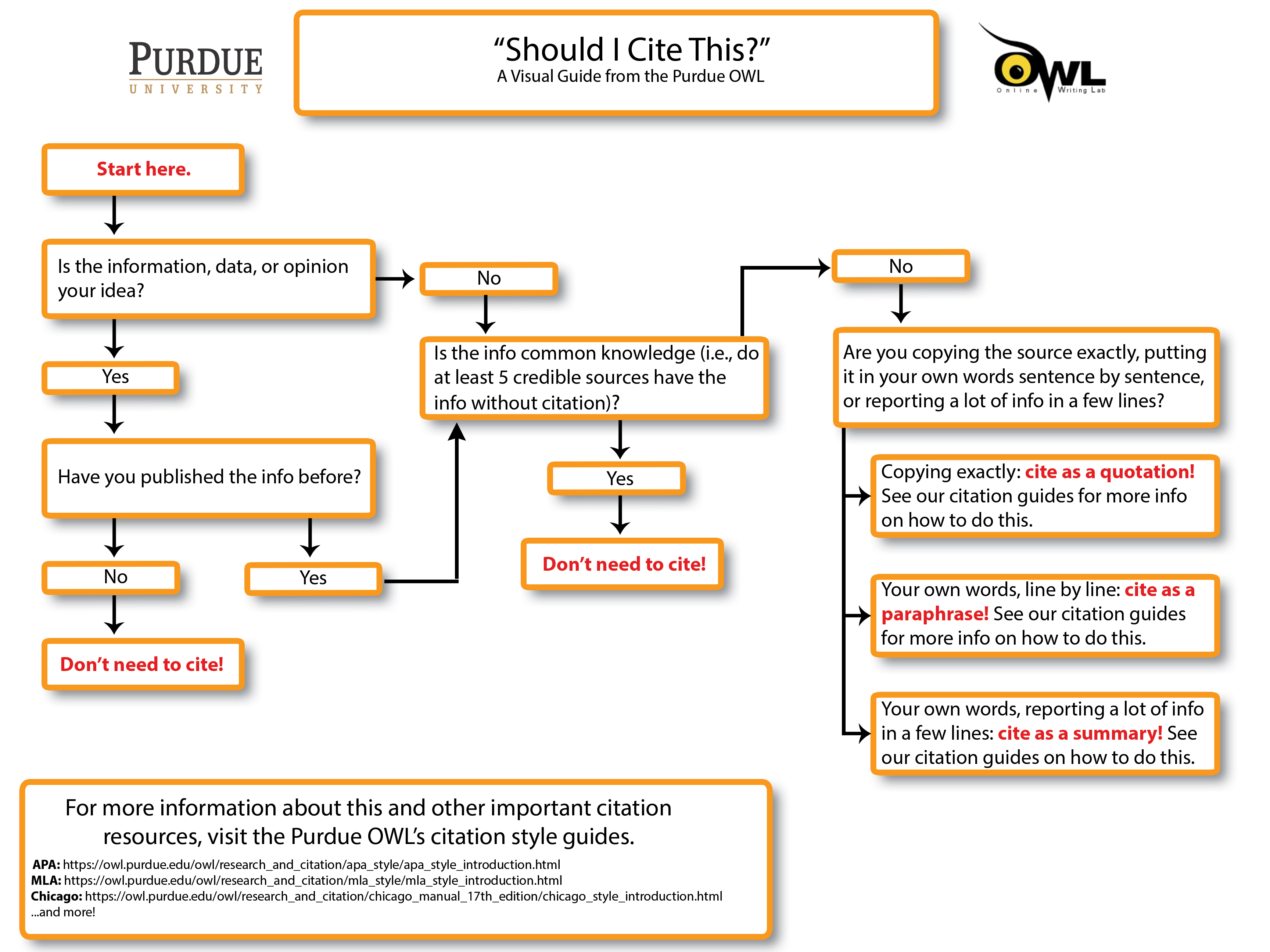Or visit the Getting Started Guide for help with library and research basics!
You MUST cite:
When in doubt--be safe and cite your source!
Citations may look different, depending on what is being cited and which citation style was used to create them. It is important to choose an appropriate style guide for your needs, and your instructor will provide you with their expected citation style for their assignments.
Authors - R. Cuhel & C. Aguilar
Article Title - Ecosystem Transformations of the Laurentian Great Lake Michigan by Nonindigenous Biological Invaders
Source Title - Annual Review of Marine Science
Volume and issue - Vol 5 no. 1
Publication Date - 2013
Page numbers - 289-320
MLA Style : Cuhel, Russell L., and Carmen Aguilar. "Ecosystem Transformations of the Laurentian Great Lake Michigan by Nonindigenous Biological Invaders." Annual Review of Marine Science, vol. 5, no. 1, 2013, pp. 289–320.
APA Style: Cuhel, R. L., & Aguilar, C. (2013). Ecosystem transformations of the Laurentian Great Lake Michigan by nonindigenous biological invaders. Annual Review of Marine Science, 5(1), 289–320. https://doi.org/10.1146/annurev-marine-120710-100952
Chicago Style: Cuhel, Russell L., and Carmen Aguilar. "Ecosystem Transformations of the Laurentian Great Lake Michigan by Nonindigenous Biological Invaders." Annual Review of Marine Science 5, no. 1 (2013): 289–320.
AMA Style: Cuhel RL, Aguilar C. Ecosystem transformations of the Laurentian Great Lake Michigan by nonindigenous biological invaders. Annu Rev Mar Sci. 2013;5(1):289–320. doi:10.1146/annurev-marine-120710-100952
The American Psychological Association (APA) style is most commonly used to cite sources within the social sciences.
The APA Style Manual 7th ed is available in Course Reserves (circulation desk), Reference (short stacks), and Main Stacks:
BF76.7 .P83 2020
The Modern Language Association (MLA) citation format is most commonly used to cite sources within the language arts, cultural studies, and humanities disciplines.
The MLA Handbook is available in Course Reserves (circulation desk), Reference (short stacks), and Main Stacks:
LB2369 .G53 2021
AMA is the expected citation style for CUW's School of Pharmacy.
View the NLM Style Guide (Alternative format)
The AMA Manual of Style, 11th ed is available in Reference (short stacks):
R119 .A533 2020
Chicago Manual of Style (CMOS) is most commonly used to cite sources in academic writing, particularly in the humanities and social sciences. Its intended purpose is primarily for published works rather than class papers.
Unlike many other citation styles, CMOS offers two different methods to document sources: the Author-Date system and the Notes-Bibliography (NB) system. The notes-bibliography style uses footnotes or endnotes, while the author-date style uses in-text citations and a reference list.
The Chicago Manual of Style 17th ed. is available in Reference (short stacks), and Main Stacks:
PN147 .U69 2017
Put simply, plagiarism is the use of another's work--whether it's their words, ideas, or images--without attribution. Plagiarism is considered to be a form of theft, and is in direct violation of CUW's Academic Ethics policy.
Plagiarism can be intentional or unintentional--remember, just because you didn't mean to doesn't mean it isn't plagiarism!
Always give credit where credit is due. If the words that you are including in your research belong to someone else, give credit.
Here is a brief list of what needs to be credited or documented:
There are certain things that do not need documentation or credit, including:
Quoting is to copy the exact words from a source, person, or document. This is fine as long as you place quotations around the passage you're quoting and properly cite the source. Be sure to:
Paraphrasing is restating a passage or source using your own words. It is different from summarizing, but paraphrasing retains the same amount of detail as the original text and explains a specific idea or argument. There are acceptable and unacceptable ways to paraphrase, so being familiar with how to properly paraphrase is important to avoid plagiarism. Be sure to:
Visit Indiana University's Writing and Tutoring Center webpage on plagiarism to view examples of proper and improper paraphrasing.
Summarizing involves putting the main ideas of someone else into your own words. It is similar to paraphrasing, but it condenses a larger text into a shorter overview and is intended to highlight the main idea or key argument. It is often significantly shorter than the text being summarized.
Whether you are quoting, summarizing, or paraphrasing, you must cite your sources whenever you use any research, ideas, or words that are not your own. If something is not general or common knowledge, you must cite where you found your information.
In addition to in-text citations, you must also include a bibliography at the end of your paper that lists all sources used.
Generally, common knowledge is information that you can find, undocumented or uncited, in at least five credible sources. Common knowledge typically falls under one of these categories:

When in doubt, cite it!
